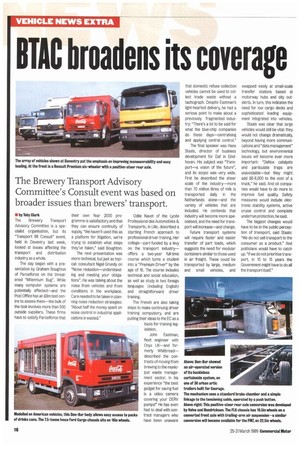BTAC broadens its coverage
Page 18

If you've noticed an error in this article please click here to report it so we can fix it.
The Brewery Transport Advisory Committee's Consult event was based on broader issues than brewers' transport.
• by Toby Clark
The Brewery Transport Advisory Committee is a specialist organisation, but its "Transport 99 Consult" event, held in Daventry last week, looked at issues affecting the transport and distribution industry as a whole.
The day began with a presentation by Graham Boughton of ParceiForce on the threatened "Millennium Bug". While many computer systems are potentially affected—and the Post Office has an 28m test centre to assess them—the bulk of the task involves more than 500 outside suppliers. These firms have to satisfy Parceiforce that
their own Year 2000 programme is satisfactory and that they can ensure continuity of supply. "We haven't used this as a platform for litigation, were trying to establish what steps they've taken," said Boughton.
The next presentation was more technical, but just as topical: consultant Nigel Grundy on "Noise reduction—understanding and meeting your obligations". He was talking about the noise from vehicles and from conditions in the workplace. Care needed to be taken in planning noise reduction strategies: "About half the money spent on noise control in industrial apprications is wasted." Odile Navet of the Lycee Professionel des Automobiles & Transports, in Lille, described a startling French approach to professional driver training. Her college—part-funded by a levy on the transport industry— offers a two-year full-time course which turns a student into a "Premium Driver" by the age of 18. The course includes technical and social education, as well as study in two foreign languages (including English) and straightforward driver training.
The French are also taking steps to make continuing driver training compulsory, and are putting their ideas to the EC as a basis for training legislation.
John Eastman, fleet engineer with Onyx UK—and formerly Whitbread— described the contrasts of moving from brewing to the municipal waste management sector. In his experience "the best gadget for saving fuel is a video camera covering your DERV pumps!" He has even had to deal with contract managers who have been unaware
that domestic refuse collection vehicles cannot be used to collect trade waste without a tachograph. Despite Eastman's light-hearted delivery, he had a serious point to make about a previously fragmented industry: "There's a lot to be said for what the blue-chip companies do these days—centralising and applying central control."
The final speaker was Hans Staals, director of business development for Daf in Eindhoven. His subject was "Transport—a vision of the future", and its scope was very wide. First he described the sheer scale of the industry--more than 70 million litres of milk is transported daily in the Netherlands alone—and the variety of vehicles that are included. He contends that industry will become more specialised, and the need for transport will increase—and change.
Future transport systems will require faster and easier transfer of part loads, which suggests the need for modular containers similar to those used in air freight. These could be transported by large, medium and small vehicles, and swapped easily at small-scale transfer stations based at motorway hubs and city outskirts. In turn, this indicates the need for low cargo decks and sophisticated loading equipment integrated into vehicles.
Staals was clear that large vehicles would still be vital: they would not change dramatically, beyond having more communications and "data management" technology, but environmental issues will become ever more important: "DeNox catalysts and particulate traps are unavoidable—but they might add i6-8,000 to the cost of a truck," he said. And oil companies would have to do more to improve fuel quality. Safety measures would include electronic stability systems, active cruise control and complete underrun protection, he said.
The biggest changes would have to be in the public perception of transport, said Staals: "We do not sell transport to the consumer as a product." And politicians would have to catch up. "If we do not prioritise transport, in 10 to 15 years the Government might have to do all the transport itself:"
















































































































